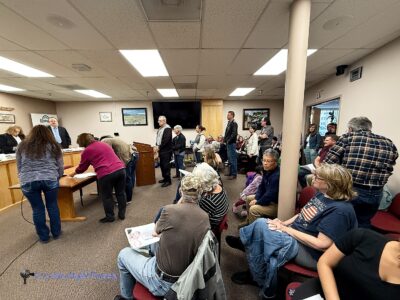by Nancy Christofferson
LAS ANIMAS COUNTY — On Feb. 9, 1866, almost exactly 150 years ago, the legislature of Colorado Territory finalized the creation of Las Animas County with Trinidad as its seat. The estimated people population was between 2,000 and 2,500, and that of cattle was 20,000 and sheep, 87,000.
Las Animas was carved from Huerfano County, and suddenly folks in places like Fort Lyon found themselves living in a different county. Fort Lyon was situated next to the Arkansas River in now Bent County and was adjacent to the present city of Las Animas. So, you see, it was a very big hunk of real estate. The new county ran from the divide on the east of the San Luis Valley all the way to Kansas, and from the New Mexico border to the Arkansas River, except for the area encompassing the new, smaller Huerfano.
The big new county was named, yes, “Los” Animas, and it lasted just two years. Pioneer Michael Beshoar wrote that it was 180 miles west to east, and 50 miles north to south. In 1868 Huerfano was cut to its present size by the territorial legislature, and a giant Bent County appeared on the northern border of Las Animas. Most folks got another new address.
That too was changed. In 1889 the state reduced Las Animas by taking off the eastern end and creating Baca County.
The residents of southeastern Colorado were used to being shuffled around. Earlier, when gold was discovered and thousands flooded the hills around Denver in 1858-59, southeastern Colorado was in New Mexico Territory. Just across the Arkansas River from Fort Lyon was Kansas Territory. So in a short number of years, addresses changed in not only counties but territories as well.
The county name is a shortened version of El Rio de las Animas Perdidas en Purgatorio, Spanish for the river of lost souls in Purgatory. The origin of this name is a bit sketchy, but the story is it was named for a group of Spanish explorers killed along its banks without receiving the last rites of the Catholic Church, which doomed them to wander in limbo between heaven and hell, or purgatory. Most sources don’t attempt to name the expedition and those that make the effort don’t agree, but it was a long time ago so all is forgiven.
Throughout all the shuffling of names and legal descriptions, Trinidad remained the county seat of Las Animas County. Though it was not the first post office established there, it is the longest lived.
By 1881 Las Animas County had 13 post offices, Alfalfa, Apishapa, Barela, Bent Canyon, Cordova, El Moro, Grinnell, Linwood, Pulaski, Starkville, Stonewall, Strange and Trinidad. Some were connected by stagecoach routes on or adjacent to the Santa Fe Trail. El Moro and Starkville were coal and coke towns. Strange became Aguilar and Stonewall stayed Stonewall. The other places were small settlements on the plains, some around the huge ranches then held by mostly easterners and others servicing homesteaders of the area. And, of course, Trinidad was Trinidad, and growing rapidly as both a railroad and stagecoach town and a center for the infant coal industry.
Though the county was established and named in 1866, the first officials were not appointed by the territorial legislature until 1867. Councilman was B.B. Field, who lived on the lower Huerfano, and representative was Thomas Suaso. Felipe Baca, an electee, became representative in 1870.
The first county commissioners of 1867 were Jacob Beard, Isaac Van Bremer and Helario Madril, who were appointed to serve until the first regular election. This occurred later that year when Lorenzo A. Abeyta, James S. Gray and Wilford B. Witt were elected commissioners and George S. Simpson became county clerk.
The first county assessment for taxation purposes was in 1867 and was $224,507. In 1876, this had leaped to $2,306,218 and in 1880, $2,768,687. The county’s 241,343 acres in 1880 were assessed at $914,612. Besides acreage, also counted were 456,524 cattle, 78,567 sheep, 412 swine and 3,030 goats. 1880 was made notable by an overnight stay in Trinidad by President U.S. Grant, who traveled there by rail. The Atchison Topeka and Santa Fe had arrived in town two years earlier, connecting Trinidad to the east and west. To visit Denver, a resident would have to drive the few miles to El Moro to embark on the Denver and Rio Grande Railroad which had built that far in 1876 and developed the town.
Agriculture was king in Las Animas in the early days. Livestock and crops were shipped out by the thousands of tons, as well wool, hides and pelts. Timber and lumber shipments totaled a little less than two million pounds. El Moro was sending out coal and coke. The Stonewall Valley was a huge producer of beef and potatoes that were freighted by wagon to the railhead.
The railroads were also shipping into Las Animas County. Accounting for the largest tonnage were, blasting powder, beer, machinery, lime, fire brick and iron. Most of these were destined for the coal camps.
Starkville was one of the earliest mines to be developed commercially on a large scale. It was opened in the 1870s, and by 1880 the town had a population of about 400.
Alfalfa was one of the prairie towns, some 20 miles due east of Trinidad on the Purgatory River. The first settlers built irrigation ditches and homes in 1864, and it is assumed they grew a lot of alfalfa. The area also raised stock, fruit and other forage and food crops. Its first post office opened in 1878 and was called Raton. It was changed to Alfalfa in 1881 and disappeared in 1923.
Bent Canyon had been settled by ranchers and was on the stage line. It too specialized in crops and livestock. The population in the immediate area was estimated at 200 but its post office, established in 1872, moved three or four times and closed forever in 1902.
Cordova was a plaza in the Purgatory Valley also called East Weston, west of Trinidad. The post office operated from 1881 to 1889 when it was moved to Weston.
Grinnell in 1881 was a post office 25 miles east of Trinidad near the New Mexico border. This was sheep country, and the 28,000 local animals produced about 100,000 pounds of wool in the late 1870s. Population was about 450. A tour guide explained it as: “Sheep and cattle, goats and babies, American and Mexicans, half and half, comprise the place and surroundings.” Its post office was operational from 1878 to 1883.
Linwood was north of Trinidad on the Purgatory, and six miles from Hoehne. Most of the land was irrigated and crops included wheat, oats, alfalfa, vegetables, and native grapes. Cattle, sheep and goats were numerous, as the area had what was termed “the best grass lands in the world”. Lifespan of its post office was from 1876 to 1886.
Pulaski was also an agricultural and stockraising center in 1880, but also shipped some coal. It was irrigated and near the Santa Fe right of way, so it had a guaranteed population between 1874 and 1886 when its post office operated. Its location can be surmised by the fact the office moved in the latter year to Hoehne, two miles away.
In less than 20 years these prairie towns would be overshadowed by the coal camps stretching north, west, south and east of Trinidad, and because of which Las Animas would become known as an industrial county rather than agricultural.

150 and Counting
More from NewsMore posts in News »
- Raton Commissioners Discuss Reproductive Clinic at Tuesday’s Meeting
- Questa/Maxwell/Raton Cheer Place 1, 2, 3 at A-AA NM State Spirit Competition
- Springer Electric Coop Schedules Planned Power Outage for Monday, March 24, 2025
- Raton Public Service Planned Power Outage Monday, March 24, 2025 to Coincide With Springer Electric Coop Planned Outage




